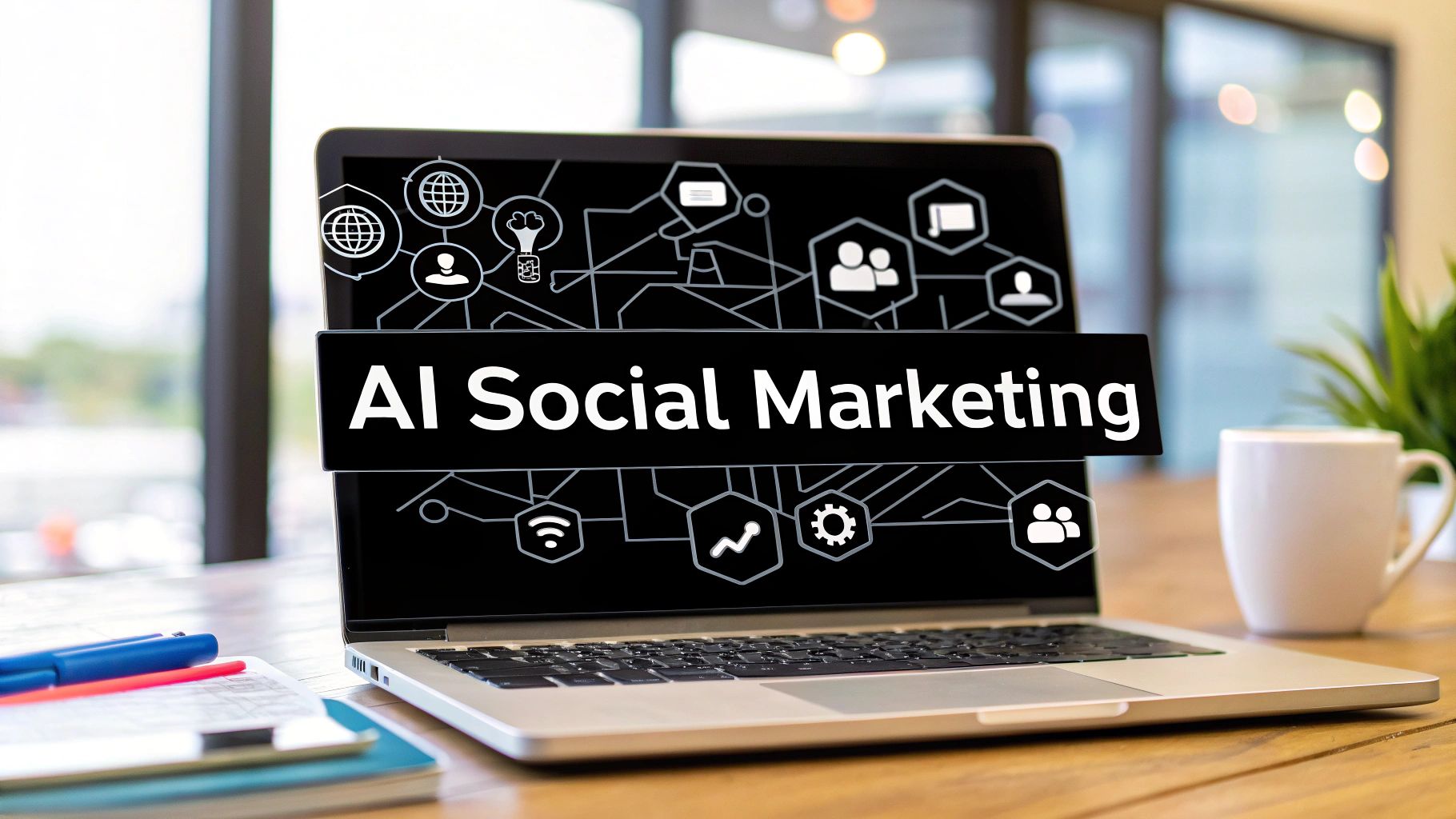
AI for Social Media Marketing A Practical Guide
Discover how AI for social media marketing can transform your strategy. This practical guide covers essential tools, benefits, and implementation steps.
The idea of using AI for social media marketing isn't some far-off concept anymore. It's here, and it’s what separates the brands that are getting ahead from those just trying to keep up.
Trying to run social media today without AI is like trying to cook a gourmet meal with just a butter knife. Sure, you might get it done, but it's going to be messy, slow, and you'll miss out on a lot of opportunities.
The New Reality of Social Media Marketing
This guide isn't about throwing buzzwords at you. It’s a practical look at how you can actually weave AI into your daily social media grind. We'll explore how AI becomes your most valuable team member—handling everything from creating content and scheduling posts to analyzing your audience and even predicting what's going to trend next.
It's no longer a question of if you should use AI, but how fast you can get it working for you.
The shift is already happening. As of 2025, AI is deeply embedded in social media strategies across the board, completely changing how brands operate. A survey of 3,864 social marketers revealed that over 75% of social media strategists—we're talking senior execs and VPs—are using AI tools to help them out. What's really interesting is that the planners and big-picture thinkers use AI even more than the folks on the ground executing the campaigns. This shows just how valuable it is for high-level decision-making. You can dig into the full social media trends report for a closer look.
Why AI is a Non-Negotiable Tool
Think of AI not as a replacement for your team, but as a super-powered assistant that takes care of the grunt work. This frees you and your team up to focus on what humans do best: strategy, building a community, and making real connections.
The biggest wins with AI fall into three main areas.
- Efficiency: It automates the tedious stuff. Think post scheduling, comment moderation, and pulling performance reports. This alone can save you hours every single week.
- Creativity: AI is a fantastic cure for creative block. It can brainstorm content ideas, draft copy that pops, and even design visuals to get you started.
- ROI: This is the big one. AI helps you get the most out of every dollar by optimizing your ad spend, finding high-value audiences, and giving you predictive insights.
AI doesn't just make social media easier; it makes it smarter. It takes mountains of data and turns it into clear, actionable steps that lead to real growth and a better return on your investment.
This infographic breaks down how AI supports these three pillars of a modern marketing strategy.
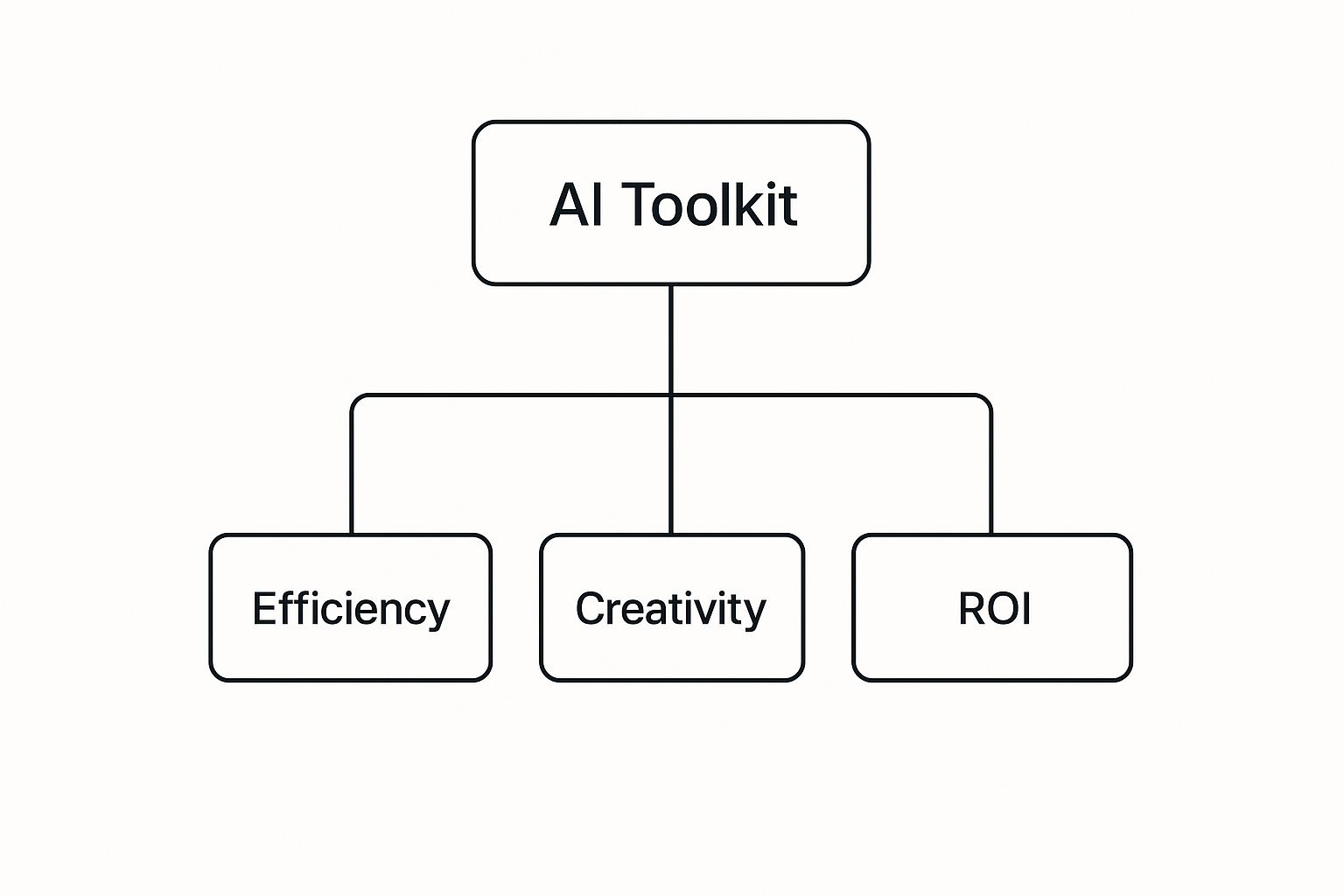
As you can see, the gains you get in efficiency and creativity aren't just nice-to-haves; they directly fuel a higher ROI. In the next few sections, we’ll get into the specifics of how to put this powerful toolkit to work.
Understanding How AI Powers Your Strategy
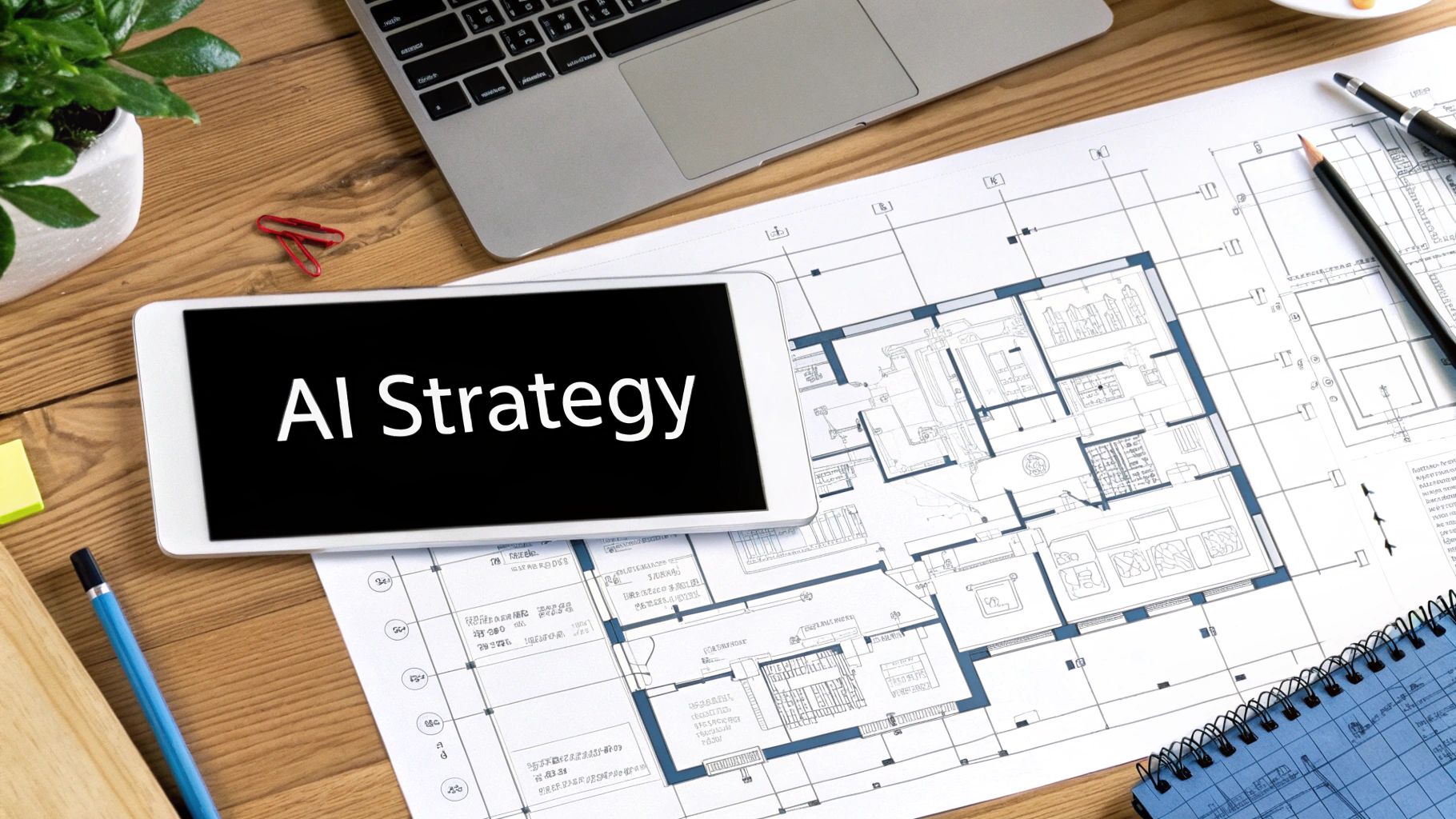
To really get the most out of AI in social media, you have to peek behind the curtain. Think of it like building a high-tech smart home. You can’t just toss a bunch of materials in a pile and hope for the best; you need a solid blueprint where every component works together.
AI provides the four essential pillars for this project. Each one has a specific job, but when you combine them, you get a powerful, self-optimizing marketing engine that works smarter, not just harder.
Let’s break down how this actually works.
To make this crystal clear, I've organized these functions into what I call the "Four Pillars of AI in Social Media Marketing." Each one builds on the last, creating a complete system for growth.
| Pillar | Primary Goal | Example Applications | | :--- | :--- | :--- | | Content Generation | To create a consistent stream of relevant posts, images, and videos. | Suggesting viral-worthy post ideas, drafting ad copy, creating visuals. | | Audience Insights | To understand who your customers are on a deeper level. | Building detailed user personas, identifying hidden audience segments. | | Performance Analytics | To predict future outcomes and optimize strategy in real-time. | Forecasting campaign success, identifying posts likely to go viral. | | Automation | To handle repetitive tasks, freeing up human creativity. | Smartly scheduling posts, moderating comments, filtering spam. |
These pillars aren't just separate features; they're interconnected parts of a modern marketing machine. Let's look at each one up close.
The Foundation: Content Generation
Content is the bedrock of your entire social media presence. Simple as that. Without a steady flow of engaging posts, videos, and stories, you have nothing to build on. AI-driven content generation acts as your foundation, giving you the raw materials to work with at a scale that used to be unthinkable.
This isn't about replacing human creativity—it's about amplifying it. AI tools can instantly analyze top-performing content in your niche to spot patterns, hot topics, and formats that get people talking. They can then spin up dozens of post ideas, write first drafts of copy, or even create unique visuals from a simple prompt. All in minutes.
- Brainstorming: An AI can give you a month's worth of content ideas from a single keyword, saving you hours of research.
- Drafting: It can spit out multiple versions of ad copy for A/B testing, each aimed at a different audience segment.
- Visuals: AI image generators can create stunning, on-brand graphics from text descriptions alone.
To see what's out there, check out some of the top AI content generation tools that brands are using to supercharge their creative workflow. This foundational support means you’ll never stare at a blank content calendar again.
The Walls: Audience Insights
If content is the foundation, then understanding your audience builds the walls that give your strategy shape and direction. A house without walls is just a concrete slab; a social strategy without audience insights is just shouting into the void. AI turns mountains of raw data into a clear picture of who your customers are.
AI algorithms dig through millions of data points—likes, shares, comments, demographics, and online behaviors—to build detailed user personas. This goes way beyond basic analytics. It finds the subtle patterns and motivations that a human analyst could easily miss, helping you answer questions like, "When are my best customers actually online?" or "What do they care about outside of my industry?"
By analyzing vast datasets, AI gives you a 3D view of your audience. It helps you understand not just what they do, but why they do it, so you can create content that feels like it was made just for them.
The Roof: Performance Analytics
With your foundation and walls in place, you need a roof to protect your work and ensure it lasts. That’s exactly what AI-powered performance analytics does. It stops you from just looking in the rearview mirror and starts predicting what’s around the corner.
Traditional analytics tell you what happened last week. AI-powered analytics tells you what’s likely to happen next week.
This predictive power is a complete game-changer. AI models can forecast campaign performance, flag which posts have the potential to go viral, and even alert you to shifts in audience sentiment before they blow up. This lets you get ahead of the curve, doubling down on what’s working and cutting your losses on what isn't.
The Plumbing: Automation
Finally, every smart home needs plumbing to make everything run smoothly. Automation is the plumbing of your AI-powered social media strategy. It handles all the repetitive, time-sucking tasks that are necessary but drain your team’s creative energy.
Smart automation takes care of the grunt work, making sure your strategy runs like clockwork without someone having to manually pull every lever.
- Smart Scheduling: AI figures out the absolute best time to post each piece of content for maximum engagement and puts it on the calendar for you.
- Comment Moderation: It can filter out spam, flag negative comments for a human to review, and even auto-reply to common questions.
- Workflow Integration: It connects your different tools, so data flows from your analytics dashboard to your content creator without a hitch.
By automating these chores, AI frees up your team to focus on what really matters: strategy, community building, and creative ideas. You know, the stuff that builds a brand people actually care about.
Putting AI to Work in Your Daily Tasks
It's one thing to talk about AI in theory, but where the rubber really meets the road is in your day-to-day grind. Let's look at how this tech actually changes the game for social media managers with a few real-world "before and after" scenarios.
Before AI, building a content calendar felt like a guessing game. You'd be staring at a spreadsheet, trying to intuit the best times to post and crossing your fingers that your content would hit the mark. It was a ton of manual work, and honestly, a lot of it was just guesswork.
With AI, that same calendar is transformed into a smart, data-backed schedule. Modern tools analyze your past performance and your audience's online habits to pinpoint the exact best times to post for maximum engagement. What used to be a shot in the dark is now a strategic advantage.
This screenshot from Hootsuite, a popular social media management platform, shows this in action. The tool takes the uncertainty out of scheduling by recommending posting times based on your specific audience data.
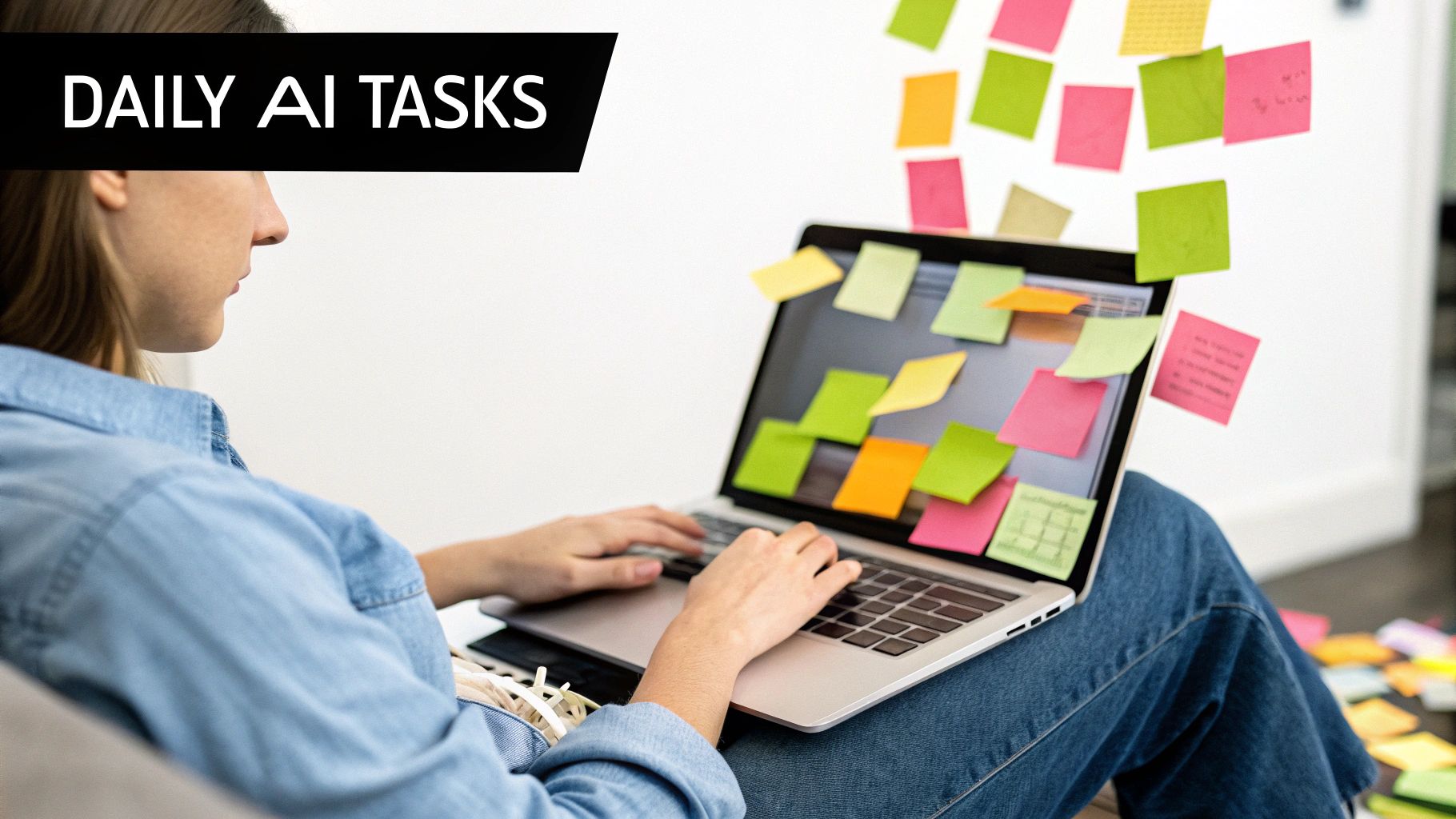
The big takeaway? AI gets you away from a generic, one-size-fits-all schedule and into a personalized calendar that adapts to your followers, pushing your visibility and interaction way up.
Supercharging Content Creation and Testing
Another huge time-suck for marketers is creating and testing ad copy. Manually writing five different headlines, three versions of the body text, and a few calls-to-action for a simple A/B test could easily eat up your afternoon.
Now, imagine having an AI assistant. You give it the core message, and it spits out dozens of variations in seconds—different tones, hooks, and angles you might not have even considered. This lets you test a much wider pool of creative ideas, helping you find what really works in a fraction of the time.
And it’s not just about speed. AI can be a fantastic partner for breaking through creative blocks. If you feel like you're running on empty, resources like Spark Creativity: 10 Innovative Ways to Ignite Ideas can help kickstart new campaigns.
The numbers back this up. A solid 93% of marketers using AI do so to create content faster. Another 81% use it to pull actionable insights from their data more quickly, and 90% rely on it for faster decision-making. It's become essential.
From Raw Data to Actionable Insights
We all know social listening is critical. But trying to sift through thousands of comments and mentions to find the important stuff? That's a Herculean task. The "before" picture is a marketer drowning in a sea of raw data, completely overwhelmed and struggling to spot trends.
The "after" picture is much cleaner. AI-powered tools can automatically analyze all that chatter and deliver concise, actionable reports.
AI acts as a sophisticated filter, separating the noise from the signal. It identifies emerging trends, tracks brand sentiment in real time, and highlights urgent customer issues that need immediate attention.
This flips social listening from a passive monitoring chore into a proactive, strategic weapon.
Streamlining Community Management
Finally, let’s talk about community management. Manually deleting spam, answering the same questions over and over, and trying to spot high-priority DMs is a relentless, 24/7 job.
AI completely changes this workflow by automating the initial triage.
- Spam Filtering: It automatically hides or zaps spammy and inappropriate comments, keeping your community spaces clean.
- Urgent Alerts: It can flag comments that signal a serious customer service issue, making sure a human can jump in right away.
- FAQ Responses: AI chatbots can handle the routine questions, giving your audience instant answers without you lifting a finger.
By taking over these repetitive (but necessary) tasks, ai for social media marketing tools free up community managers to do what they do best: build real relationships and have meaningful conversations. The result isn't just time saved—it's a healthier, more responsive community.
How AI Drives Measurable Business Growth
Efficiency and fresh ideas are great, but let's be honest—the real goal is a return on your investment. This is where AI in social media truly proves its worth, connecting smart tech directly to your bottom line. It stops being about just saving time and starts becoming a powerful engine for growing revenue.
Instead of just making your team faster, AI makes every dollar you spend work harder. It does this by supercharging three key areas: optimizing your ad spend, nailing your influencer marketing, and capitalizing on the boom in social commerce. Each one gets a massive boost from AI's ability to crunch the numbers, turning potential into actual profit.
Let's break down how AI actually grows your ROI and why it’s a no-brainer for your growth strategy.
Maximizing Your Ad Spend
Running traditional ad campaigns can feel a bit like throwing spaghetti at the wall. You set a budget, launch your ads, and wait for the data to trickle in before you can figure out what's working. That lag time means you’re probably burning cash on audiences or creative that just isn't landing.
AI completely flips that script.
Imagine having a top-tier analyst glued to your campaigns 24/7, making instant, data-backed decisions. That's essentially what AI algorithms do. They watch performance data in real time—clicks, conversions, engagement—and automatically shuffle your budget away from the duds and over to the winners. This constant adjustment means your money is always backing your best-performing ads. No more waste.
- Real-time Optimization: AI automatically funnels your budget toward the ads and audiences that are actually converting.
- Predictive Targeting: It can find lookalike audiences that are almost guaranteed to convert before you even spend a dime targeting them.
- Creative A/B Testing: AI can spit out and test dozens of ad variations to pinpoint the perfect mix of words and images for the best results.
By constantly fine-tuning where your money goes, AI squeezes more conversions out of the same budget, giving your ROI a direct and immediate lift.
Precision in Influencer Marketing
Influencer marketing isn't just about paying someone with a huge follower count anymore. Real success comes from finding creators whose audience is a perfect match for your brand and is actually paying attention. Trying to vet influencers by hand is a slow, painful process that often relies on vanity metrics like follower counts, which we all know can be faked.
AI platforms bring a dose of science to the art of influencer selection. They can dig deep into an influencer's content, audience demographics, the quality of their engagement, and how their past campaigns performed to predict their potential ROI with scary accuracy. This data-first approach helps you dodge those costly mismatches and partner with people who will actually move the needle.
AI-driven analytics and personalization are delivering huge returns here. On average, brands are seeing $5.78 in revenue for every $1 spent on influencer campaigns—that's nearly double the ROI of old-school ads.
This works because people trust people. In fact, 61% of consumers trust recommendations from influencers more than they trust ads from brands. When you use AI to find the right partners, you're tapping into that trust in a much smarter way. You can find more stats on the impact of AI on influencer marketing ROI on sprinklr.com.
Turning Social Scrolling into Sales
Finally, AI is changing the game for social commerce, turning platforms like Instagram and Facebook from places where people just browse into active storefronts. The gap between seeing a product and buying it is getting smaller every day, all thanks to smart automation.
AI-powered chatbots are leading the charge. They can instantly answer questions about a product, offer up personalized recommendations, and walk a customer through checkout right there in the chat window. This seamless experience captures the sale in that moment of peak interest, which dramatically cuts down on abandoned carts.
On top of that, AI recommendation engines watch a user's behavior to show them products they're most likely to fall in love with, turning a casual scroll into a personalized shopping spree. It’s a win-win: you increase conversion rates and often boost the average order value, too. Of course, tracking all this is critical, and you can learn more about how to measure social media ROI in our full guide.
Choosing the Right AI Tools for Your Team
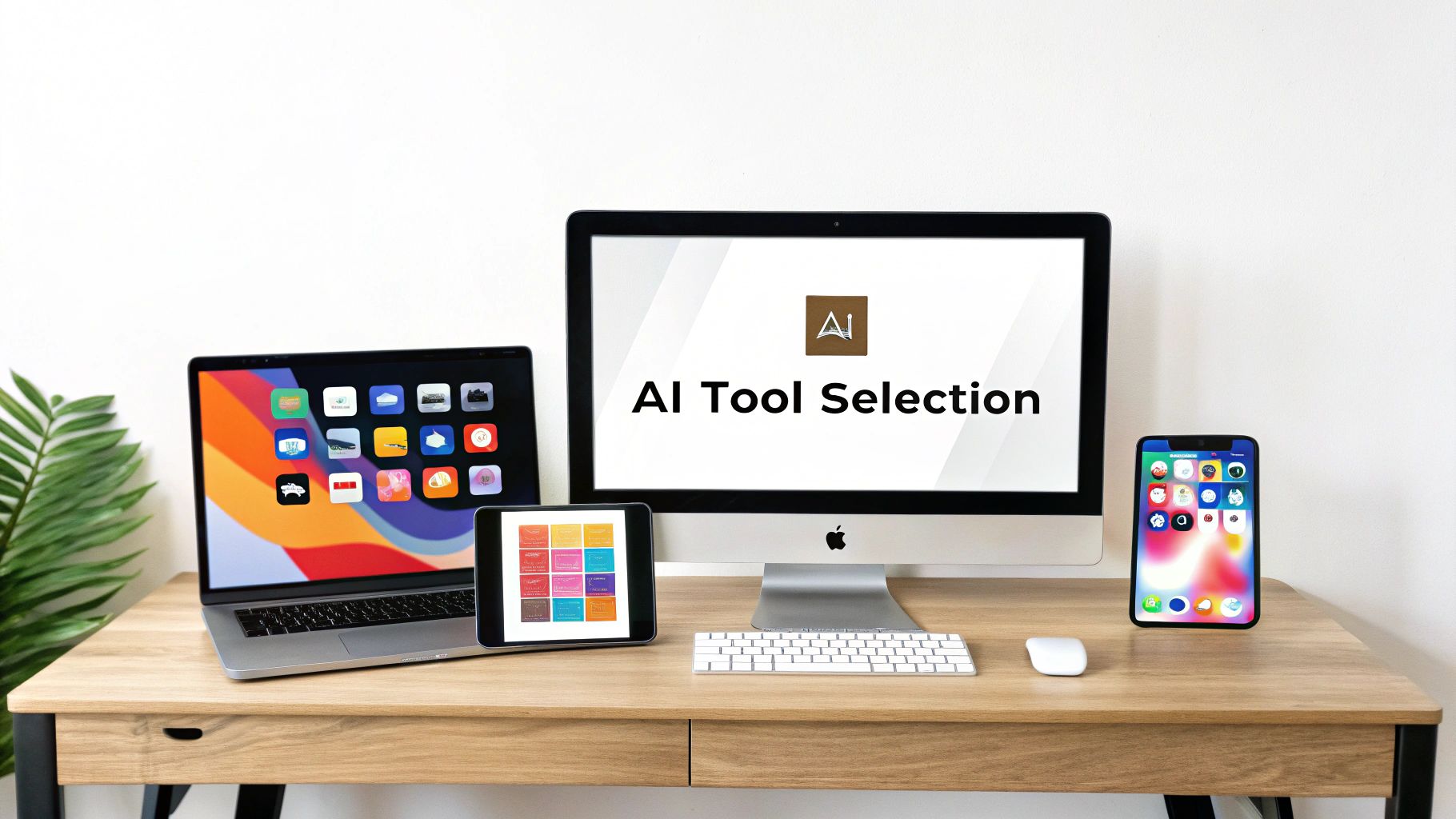
The market for AI social media tools is exploding. It feels like a new must-have platform pops up every other week. While all this choice is great, it’s easy to get stuck in decision paralysis. How do you find the one tool that actually fits your workflow, budget, and goals without getting lost in a sea of features?
The secret is to stop looking for the "best" tool and start looking for the best tool for you. It's a bit like buying a car; a zippy two-seater sports car is perfect for a solo city driver but totally useless for a family of five. Your team's real, day-to-day needs have to be the driving force.
To cut through the noise, let's break it down into a simple, three-step framework. This approach will help you filter out the distractions and zero in on a platform that genuinely solves your problems.
Start with Your Biggest Pain Point
Before you watch a single demo or read a single feature list, look inward. What is the single biggest bottleneck slowing your social media team down right now? Pinpointing this is the most important first step, because it gives your search a clear purpose.
Are you constantly scrambling for content ideas? Maybe your team spends half its day just writing and rewriting post copy. Or perhaps you have tons of content going out, but no real idea what’s actually resonating with your audience.
Your primary pain point is your compass. It guides you toward a category of tools designed to solve that exact problem, preventing you from getting distracted by shiny features you don’t actually need.
Once you know what you’re trying to fix, you can start exploring solutions built for that purpose. For instance, if coming up with fresh ideas is the main hurdle, you’ll want to check out the world of AI content creation. You can find some great options among these 12 AI content creation tools to see what clicks with your creative process.
Define Your Budget and Integration Needs
Okay, you’ve identified the problem. The next step is to get real about the practical stuff every team deals with: money and existing software. AI tools range from free, single-purpose apps to powerful, enterprise-level suites that cost thousands a month. Be honest about what you can actually invest.
Just as important is how any new tool will play with your current systems. A state-of-the-art analytics platform is worthless if it can’t talk to the social media scheduler your team already knows and loves.
- Budget: Lock down a realistic monthly or annual number. Don't forget to factor in potential per-user costs if your team is growing.
- Integrations: Make a list of your non-negotiables (like Slack, Google Drive, or your current scheduler). Any new tool has to connect seamlessly, otherwise you’re just creating more work.
- Ease of Use: How much time can you spend on training? Some tools are intuitive and ready to go in minutes, while others have a steeper learning curve but offer more power in the long run.
Nailing down these practical limits will instantly shrink your list of options, making the final decision way less daunting.
Compare Tool Categories and Ask the Right Questions
Not all AI tools are built the same. They tend to fall into a few key categories, each designed for a different need. Understanding where they fit helps you quickly find the right match for your team.
To make this easier, here's a quick breakdown of the main types of AI tools you'll encounter.
Comparing AI Social Media Tool Categories
| Tool Category | Best For | Example Tools | Typical Price Range | | :--- | :--- | :--- | :--- | | All-in-One Platforms | Teams wanting to consolidate their workflow into a single tool for scheduling, analytics, and content. | HubSpot, Sprout Social | $$-$$$ | | Specialist Content Creators | Teams focused on overcoming creative blocks and producing high volumes of copy and visuals. | Jasper, Copy.ai | $-$$ | | Advanced Analytics Tools | Data-driven teams needing deep insights, trend prediction, and competitive analysis. | Brandwatch, Talkwalker | $$$-$$$$ | | Community Management Bots | Brands with high engagement volumes that need to automate responses and spam filtering. | Chatfuel, ManyChat | $-$$ |
This table should give you a good starting point for which category to explore first.
Once you've picked a category and a few promising tools, it's demo time. When you get on that call, go beyond the sales pitch. Ask targeted questions to see if the tool truly solves your problems.
Checklist of Demo Questions:
- Can you show me exactly how this tool solves [Your Specific Pain Point]?
- What does the onboarding process look like for a team our size?
- Where does your AI get its data for analytics and predictions?
- Can you walk me through the integration process with [Your Key Software]?
- What’s on your product roadmap for the next six months?
Choosing the right AI marketing software is a strategic move that pays off big in efficiency and better results. By following a structured approach, you'll find a platform that empowers your team instead of overwhelming them.
Building Your AI Implementation Roadmap
Jumping into AI for social media marketing isn't an overnight switch. Trying to do everything at once is a surefire way to get overwhelmed and give up.
Think of it as a three-phase journey. This approach lets you and your team build skills and confidence over time, moving from simple tests to full-blown strategic integration without burning out. It’s all about building momentum, not just flipping a switch.
Phase 1: Experimentation
Your first step? Just start playing.
The goal here is low-risk experimentation to get comfortable with the tools. Don't get bogged down with ROI or complex strategies yet. Just pick a small, specific task and see what happens.
For example, grab a free AI writing assistant and ask it for ten different hooks for your next Instagram Reel. Or have it brainstorm a week's worth of tweet ideas. You’ll see the immediate value and get a feel for the tech in a safe, controlled way. This is your AI sandbox.
"Your job will not be taken by AI. It will be taken by a person who knows how to use AI. So, it is very important for marketers to know how to use AI."
Phase 2: Integration
Once your team has its sea legs, it’s time to get a little more serious.
This phase is all about picking one primary AI tool that solves a real pain point and weaving it into your daily workflow. Maybe it's a content scheduler that predicts the best times to post or an advanced social listening tool that uncovers hidden conversations.
Success here comes down to commitment. Set aside dedicated time for your team to learn the new platform. More importantly, set clear key performance indicators (KPIs) to track its impact. Are you saving time on content creation? Seeing a lift in engagement on AI-scheduled posts? Measure it.
Phase 3: Scaling and Strategy
Now you’re ready to scale. With a core tool successfully integrated and proving its worth, you can expand AI's role across your entire social media function.
This is where AI graduates from being a simple task-doer to a genuine strategic partner. Its insights should start guiding your high-level decisions.
At this stage, your team should be using AI to:
- Inform Strategy: Use predictive analytics to spot upcoming trends and decide on your content pillars for the next quarter.
- Optimize Campaigns: Let AI manage and optimize your ad spend across platforms to squeeze every drop of ROI from your budget.
- Deepen Audience Understanding: Dig into AI-driven insights to refine your customer personas and discover new, untapped audience segments.
Following this phased roadmap ensures you build a solid foundation, set achievable goals, and create a culture where AI is seen as a powerful collaborator—not a replacement for human creativity.
Got Questions About AI in Social Media? Let's Talk.
Jumping into AI for your social media always brings up a few big questions. It's totally normal to wonder about the real-world stuff—how much does this cost? Is a robot going to take my job? Where do I even begin?
Let's clear the air and tackle these head-on so you can move forward with confidence.
How Much Do AI Social Media Tools Actually Cost?
The price tag on AI tools is all over the map. You can find everything from completely free, basic helpers to massive enterprise platforms that cost a small fortune. There’s really no single answer here, because what you pay depends entirely on your needs.
My advice? Start small. Pick one specific headache you want to solve—maybe it’s coming up with post ideas or just getting your content scheduled—and find a cheap or free tool that does just that. Once you see a good return on that small investment, you'll feel much more comfortable scaling up to something more powerful.
Will AI Replace Social Media Managers?
Nope. AI isn't here to replace social media managers; it's here to give them superpowers. Think of it as a force multiplier for your team's creativity. AI is brilliant at chewing through massive amounts of data and handling the repetitive, tedious tasks that drain our creative energy.
This actually frees up managers to double down on the things that humans do best (and AI can't):
- Dreaming up big-picture strategy that actually ties back to business goals.
- Creating genuinely original content that makes people feel something.
- Building real community relationships and having those nuanced, human conversations.
AI handles the mechanics, while humans drive the meaning. Your job won't be taken by AI, but it might be taken by someone who knows how to use it.
What's the Easiest Way to Get Started with AI?
The simplest, most direct way to dip your toes in is with an AI content generator. The learning curve is gentle, and you see the benefit almost immediately. You can start by asking one to brainstorm a list of blog topics, spit out a few different hooks for your next Reel, or just rewrite a caption in a different tone of voice.
A lot of the social media management platforms you might already be using have AI writing assistants built right in. Using a feature you already have access to is a fantastic, zero-friction way to begin. It delivers instant value by saving you time and sparking new ideas, making it the perfect first step into the world of AI.
Ready to see how an all-in-one AI platform can pull your whole social media workflow together? ViewPrinter combines content creation, scheduling, and analytics into one seamless experience. Start creating viral content faster and drive real results with ViewPrinter today.